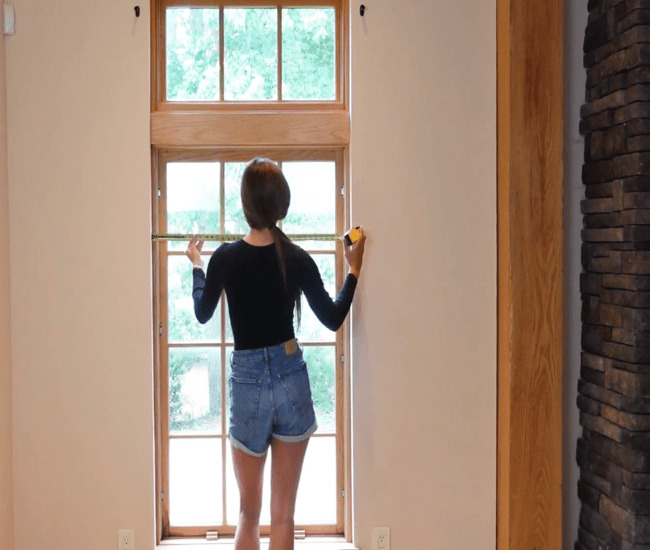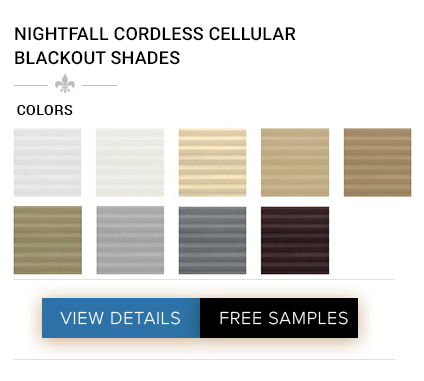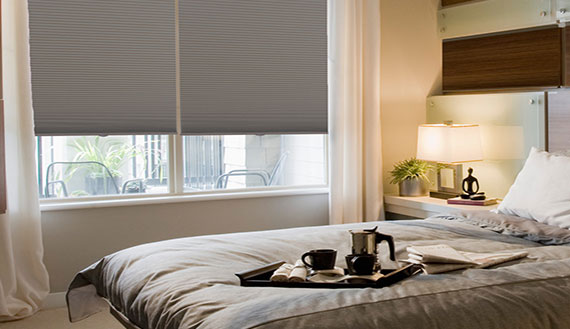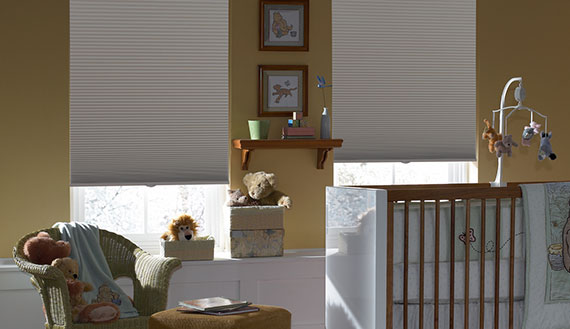Looking for cellular shades with the highest value (nearly 5.0) to maximize the energy efficiency of your home, while also enhancing its style? Consider ⅜ inch double cellular shade with 4.60 R-value, which will save you up to 20% on your heating and cooling costs.
Offering impressive energy efficiency, style, and light control, cellular shades have become a popular choice for homeowners and businesses alike. In addition to improving insulation, the honeycomb construction provides a stylish look at the window.
Insulating cellular shades offer an inexpensive and effective way to improve the thermal regulation and look of your bedroom, dining room, living room, and kid’s room (with a kid-friendly control).
Here’s a comprehensive buyer’s guide to choose the best cellular shades for your home or office.
What are Cellular Shades?

Cellular shades, also referred to as honeycomb blinds, are one of our most sought-after window treatments for energy efficiency and style. They offer versatility, functionality, and a contemporary style. A unique honeycomb design makes them very energy efficient.
There are three types of honeycomb constructions available for cellular shades or blinds.
Simpler Single Cell Design: Insulation properties are lower than those of double and triple cells designs. However, the single cell option is more affordable.
More Energy Efficient Double Cell Fabric: Get enhanced insulation and increased energy efficiency at a higher price compared to single cell blinds.
Triple Cell Construction: They offer the highest level of insulation, greater noise cancellation, and added privacy benefits. However, triple cell shades are the most expensive ones.
Note: When choosing between single cell, double cell, and triple cell designs, make sure to take into account the size of the cells.
Benefits of Cellular Shades
Saving on Heating & Cooling Costs

The main purpose of buying honeycomb or cellular shades is to save energy. They are available in single, double, and triple honeycomb design, in an increasing order of energy savings. In the hotter months, they help shield the ultraviolet light out of the house and the cool air conditioning inside. During the cooler months, they’ll keep cold away, cutting down on your home’s heating costs.
Top-Down Bottom-Up Design

Cellular shades come with a top-down bottom-up option, so you can easily raise or lower them from both top and bottom with the touch of your finger. This design also offers more versatility in light control, privacy, and insulation.
The honeycomb construction also prevents prying eyes from peeping into your privacy space. So, they are a great choice for privacy. When you need both light and privacy, you can close the bottom side, while keeping the top side open.
What to Look for When Buying Cellular Shades?
Here are some important factors to consider when buying cellular shades.
Desired Level of Insulation and Light Control

For maximum energy efficiency and light control, select triple cell honeycomb shades. Similarly, when it comes to pleat sizes, go with smaller pleats (⅜”) for more insulation and darkness. Larger pleats, like ½” and ¾” provide a more open look with less insulation.
Material Choices

Choose materials that are more durable and easier to clean. Polyester, cotton, linen, and woven fabrics are popular material options. Woven fabric is preferred for its elegant look and more insulation and light blockage.
Amount of Light You Want to Let In
Cellular shades are available in different opacities or openness levels, from sheer and light filtering to room darkening and total blackout. Depending on the amount of light you want to let in and privacy requirements, choose a suitable light filtering option.
Custom Options
Choose a cellular shade that is fully customizable to fit the size of the window and your home’s decor. Custom cellular shades are available in lots of sizes (from 20” to 72”) and color. Select a hue you want to create a particular look.

Make sure to accurately measure the window length, width, and depth (for inside mount) before purchasing a product. Click here for a detailed guide on how to measure your windows for cellular shades.
Mounting Option
Similar to most types of blinds, shades, and shutters, cellular shades can be mounted inside the window frame, outside (on the top or around) the window, or to the side of the window frame. Properly read installation instructions for different types of mounts before starting the DIY installation project.
Child Safety

Cellular shades are also available with child-safe cordless lift system. You can also go with a motorization option for a luxurious operation.
Best Cellular Blinds for Insulation & Style
Cordless Single Cell Light Filtering Shades
These shades are an excellent choice for your home’s insulation and glare reduction at a reasonable price. The bottom rails and head rails are color coordinated to complement the color you pick for your shades, giving the whole shade a stylish and harmonized look that matches the furnishing of any room in your home space.
Lightweight Top-Down Bottom-Up Cellular Shades (TDBU)
You will be startled by our unique Light Filtering Cordless (TDBU) Cellular shades! Cordless Top-Down Bottom-Up Blinds are ideal for pets or kids because the cords run through the center of the shades.
You can operate these window treatments from the bottom up or the top down to meet all your privacy needs while still getting natural light.
Blackout Cellular Shades
Blackout or nightfall cellular shades will block out 100% external light along with the sun’s harsh UV rays, maximizing energy efficiency and comfort in your home.
Day & Night Cellular Shades
This dual function (sheer + blackout) shade can either fill your room with light (when sheer fabric is open) or totally block it out (when blackout fabric is open). Blackout option of day and night cellular shades decreases heat and glare while preventing all outdoor light. Additionally, the fabric absorbs sound to decrease disturbing exterior noises.
Motorized Cellular Shades
Motorized cellular blinds come with a wireless remote control, allowing you to operate the energy efficient window coverings with the push of a button from the comfort of your bed or work desk.
Where to Buy Cellular Shades Online?

Affordable Blinds is one the best online marketplaces for buying highly quality cellular shades at affordable prices. If you buy this product here at Affordableblinds.com and get:
- Up to 70% discounts
- Free Shipping throughout the contiguous United States at no cost to you
- 110% best price guarantee.
- 100% Worry-Free Fit: We’ll take up part of the cost to get your problem resolved, if you mismeasure your window.
- A Free Lifetime Guarantee
- 100% Satisfaction Guarantee with 5-star customer care
- Free Consultancy (Measuring, Installing, Choosing Right Product)
Average Price Range of Cellular Shades

High quality double cellular light filtering shade (Elite model) would cost between $40 and $160, based on size. If you add motorization, you’ll need to pay extra. The installation charges range from $50 to $100. If you want to purchase blackout cordless cellular shades, it’ll costlier, with average price ranging from $80 to $350.
FAQs
Which cellular shades are most energy efficient?
Blackout cellular shades with ⅜” double cell fabric are the most energy efficient and lightest cellular shades. For additional insulation, privacy, and noise cancellation, you can choose ¾” shades. They will save you more than 15% on total energy from heating and cooling.
What is the R-value of a cellular shade?
The well-accepted R-value of a cellular shade ranges from 2.0 to 5.0. On the low-end of this range, a light filtering cellular shade will more than double the R-value of a single-pane window. The R-value of a cellular shade depends on the type of fabric selected. At the high end of the range, a blackout double cellular shade will quintuple the R-value. For example, the R-Factor for a ⅜ inch double cellular shade is 4.60, with a shading coefficient of 0.38.
Are blackout cellular shades more energy efficient than light filtering?
Yes! Blackout out cellular shades are significantly more energy efficient than light filtering and other types of cellular blinds. They block out 100% of sunlight from permeating your home, which reduces the quantity of energy your house will consume on cooling and heating. Blackout cellular shades save up to 20% on heating energy and 15% on cooling energy, according to the US Department of Energy.
Need More Help?
Still unsure which type of cellular blinds are best for the energy efficiency and style of your home or office? Contact our professionals using 24/7 live chat or give us a ring at (800) 863-6109 for a custom solution.








